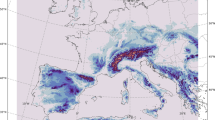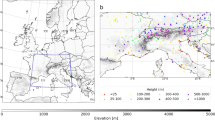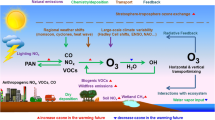Abstract
Changes in urban surface areas and population growth have significantly affected the weather and environment. Emissions of nitrogen oxides are increasing in the Pearl River Delta region. Nitrogen compounds emitted by factories and motor vehicles are the major sources of nitric pollution. To study the impacts of urbanization and the relationship between pollutant diffusion and the atmospheric environment, the nonhydrostatic mesoscale forecast model MM5 (v3.73), which was developed by Penn State University and the National Center of Atmospheric Research, and a mass continuity equation for air pollutants, were used in this study. Two experiments were designed. One experiment (BE) applied horizontal grid resolutions of 27, 9, 3, and 1 km in four nested domains. The other experiment adopted new land-use data (in domain 4) directly retrieved from Landsat Thematic Mapper imagery to replace the 1980s data of the United States Geological Survey in BE. A 48-h simulation (from 0000 UTC on 21 October to 0000 UTC on 23 October 2008) was conducted, with the first 12 h being the spin-up time and the remaining 36 h being the effective simulation, so as to capture the diurnal features of the thermally induced winds associated with the land–sea breeze and urban heat island circulations. The different results obtained from the two tests for wind circulation and air pollution dispersion and transportation in the Pearl River Delta region were analyzed. The simulated results show that the both experiments can well simulate land–sea breeze circulation and remarkable land–sea breeze evolution, comparing with observation data. The height of the PBL had a significant diurnal cycle. The structure of the wind field can obviously impact the dispersion of the NO x in three dimensions. Nitrogen oxides mainly diffused along the dominant wind direction (east or southeast wind), therefore the majority of the pollutants accumulated in the northwest region of the fine domain in both simulation experiments. However, it induced the pollutants concentration in an irregular pattern due to the fine-resolution grid spaces and complicated inland wind field in the northwest area of the inner domain. Moreover, increasing the proportion of urban surface caused sensible heat flux increase, latent heat flux decrease and humility reducing relatively in the region of urban surface characteristics apparently. Urbanization will cause pollution accumulated severely over the urban surface.













Similar content being viewed by others
References
Hidalgo, J., Masson, V., & Pigeon, G. (2008). Urban-breeze circulation during the CAPITOUL experiment: numerical simulations. Meteorology and Atmospheric Physics, 102(3–4), 223–241.
Woolum, C. A. (1964). Notes from a study of the microclimateology of the Washington, DC area for the winter and spring seasons. Weatherwise, 17, 263–271.
Bornstein, R. D. (1968). Observations of the urban heat island effect in New York City. Journal of Applied Meteorology, 7, 575–582.
Oke, T. R. (1987). Boundary layer climates (2nd ed.). London: Methuen.
Nichol, J. E., Wing, Y. F., Lam, K. S., & Man, S. W. (2009). Urban heat island diagnosis using ASTER satellite images and ‘in situ’ air temperature. Atmospheric Research, 94, 276–284.
Lo, J. C. F., Lau, A. K. H., Chen, F., Fung, J. C. H., & Leung, K. K. M. (2007). Urban modification in a mesoscale model and the effects on the local circulation in the Pearl River Delta region. Journal of Applied Meteorology and Climatology, 46, 457–477.
Lin, C. Y., Chen, F., Huang, J. C., Chen, W. C., Liou, Y. A., Chen, W. N., et al. (2008). Urban heat island effect and its impact on boundary layer development and land–sea circulation over northern Taiwan. Atmospheric Environment, 42, 5635–5649.
Du, D. S., Lin, W. S., Li, J. N., Yang, D. Y., & Ye, X. Y. (2010). Effect of land use change on summer monthly climate over the Pearl River Delta. Acta Scientiarum Naturalium Universitatis Sunyatseni, 49(1), 138–144.
Sharan, M., Gopalakrishnan, S. G., McNider, R. T., & Singh, M. P. (2000). A numerical investigation of urban influences on local meteorological conditions during the Bhopal gas accident. Atmospheric Environment, 34(4), 539–552.
Lo, J. C. F., Lau, A. K. H., Fung, J. C. H., & Chen, F. (2006). Investigation of enhanced cross-city transport and trapping of air pollutants by coastal and urban land–sea breeze circulations. Journal of Geophysical Research, 111, D14104.
Dudhia, J. (1993). A nonhydrostatic version of the Penn State/NCAR mesoscale model: validation tests and simulation of an Atlantic cyclone and cold front. Monthly Weather Review, 121, 1493–1513.
Grell, G. A., Dudhia, J., & Stauffer, D. R. (1994). A description in the fifth generation PSU/NCAR mesoscale model(MM5), NCAR Tech, Note, NCAR/TN, 398+STR, 138.
Chen, X. L., Feng, Y. R., Li, J. N., Lin, W. S., Fan, S. J., Wang, A. Y., et al. (2009). Numerical simulations on the effects of sea-land breezes on atmospheric haze over the Pearl River Delta region. Environmental Modeling and Assessment, 14(3), 351–363.
Lin, W. S., Wang, A. Y., Wu, C. S., Fong, S. K., & Ku, C. M. (2001). A case modeling of sea-land breeze in Macao and its neighborhood. Advances in Atmospheric Sciences, 18(6), 1231–1240.
Solberg, S., BergstrÖm, R., Langner, J., Laurila, T., & Lindskog, A. (2005). Changes in Nordic surface ozone episodes due to European emission reductions in the 1990s. Atmospheric Environment, 39(1), 179–192.
Yu, S., Eder, B., Dennis, R., Chu, S. H., & Schwariz, S. (2005). On the development of new metrics for the evaluation of air quality models. Atmospheric Science Letters, 7, 26–34.
Acknowledgments
This research was supported by National Program on Key Basic Research Project of China (973) under grant No. 2010CB428504, the National Natural Science Foundation of China (grant no. 40805043), and the Fundamental Research Funds for the Central Universities (grant no. 111gjc10, 11lgjc13). The Network and Information Technology Center at Sun Yat-sen University is acknowledged for providing the use of computers in the research.
Author information
Authors and Affiliations
Corresponding author
Rights and permissions
About this article
Cite this article
Zeng, LP., Lin, WS., Fan, Q. et al. Simulation of Wind Circulation and Pollutant Diffusion Over the Pearl River Delta Region. Environ Model Assess 17, 539–553 (2012). https://doi.org/10.1007/s10666-012-9314-6
Received:
Accepted:
Published:
Issue Date:
DOI: https://doi.org/10.1007/s10666-012-9314-6




